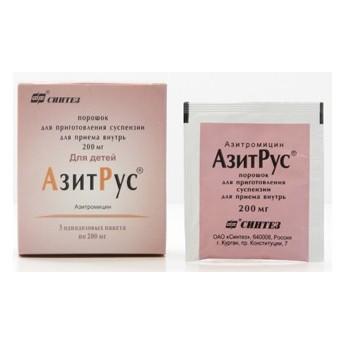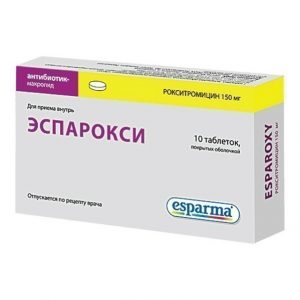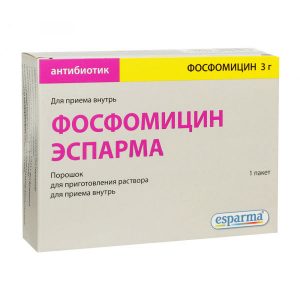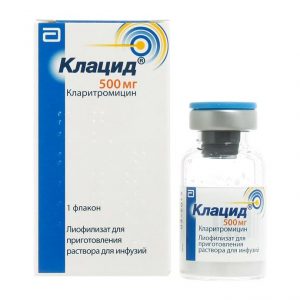Description
Release form
Powder for preparation of suspension for oral administration
Packing
3 pcs.
Pharmacological action
Azitrus is a broad-spectrum antibiotic of the macrolide group, azalide. It acts bacteriostatically. By binding to the 50S subunit of the ribosome, it inhibits protein synthesis and slows the growth and reproduction of bacteria. In high concentrations it has a bactericidal effect. It acts on extra- and intracellular pathogens. Active against gram-positive microorganisms: Streptococcus spp. (groups C, F, and G, except for those resistant to erythromycin), Streptococcus pneumoniae, Streptococcus pyogenes, Streptococcus agalactiae, Streptococcus viridans, Staphylococcus epidermidis, Staphylococcus aureus gram-negative bacteria: Haemophilus influenzae, Mohreisella perella catella Bordetella parapertussis, Legionella pneumophila, Haemophilus ducreyi, Campylobacter jejuni, Neisseria gonorrhoeae and Gardnerella vaginalis some anaerobic bacteria: Bacteroides bivius, Clostridium perfringens, Peptostreptococcus spp, as well as intracellular pathogens:. Chlamydia trachomatis, Chlamydia pneumoniae, Mycoplasma pneumoniae, Mycobacterium avium complex, Ureaplasma urealyticum, Treponema pallidum, Borrelia burgdoferi. Azithromycin is active against gram-positive bacteria that are resistant to erythromycin.
Indications
Infectious and inflammatory diseases caused by microorganisms sensitive to the drug: infections of the upper respiratory tract and ENT organs (tonsillitis, sinusitis, tonsillitis, pharyngitis, otitis media)
scarlet fever
infections of the lower respiratory tract (. including caused by atypical causative agents of pneumonia, exacerbation of chronic pneumonia, bronchitis)
infections of the skin and soft tissues (erysipelas, impetigo, secondary infected dermatoses)
urinary tract infections (gonorrheal and non-chronic urethritis)
female genital infections (cervicitis)
Lyme disease (borreliosis) in the initial stage (erythema migrans)
of the stomach and duodenal ulcer (associated with Hel p therapy).
Contraindications
renal failure
liver failure
lactation (breastfeeding)
children under 6 months of age (for suspension)
children under 3 years old and / or body weight less than 25 kg (for capsules)
children / or body weight less than 50 kg (for tablets, film-coated)
hypersensitivity to the components of Azitrus, as well as to other macrolides.
Use during pregnancy and lactation
Use during pregnancy is only possible when the intended benefit to the mother outweighs the potential risk to the fetus. If it is necessary to use Azitrus during lactation, breastfeeding should be discontinued.
Special instructions
The drug is not taken with meals. In case of a missed dose, the missed dose should be taken as soon as possible, and the subsequent ones with an interval of 24 hours. It is necessary to observe a break of at least 2 hours between doses of the drug AzitRus and antacid preparations. After drug withdrawal, hypersensitivity reactions in some patients may persist, in such cases, the appointment of specific therapy under the supervision of a doctor is recommended.
Composition
1 packet contains: azithromycin (in the form of dihydrate) 200 mg
excipients: sodium citrate (sodium citrate trisubstituted), aroma orange edible torus, sodium saccharinate, collidone CL-M (crospovidone), sucrose
Dosage and administration
Inside 1 hour before or 2 hours after eating 1 time per day.
Adults: for infections of the upper and lower respiratory tract – 500 mg / day for 1 dose for 3 days (course dose – 1.5 g).
For infections of the skin and soft tissues – 1000 mg / day on the first day for 1 dose, then
500 mg / day daily from 2 to 5 days (course dose – 3 g).
In acute infections of the urogenital organs (uncomplicated urethritis or cervicitis) – once 1 g.
For Lyme disease (borreliosis) for the treatment of stage I (erythema migrans) – 1 g on the first day and 500 mg daily from 2 to 5 days (course dose – 3 g).
In case of gastric and duodenal ulcer associated with Helicobacter pylori – 1 g / day for 3 days as part of combination anti-Helicobacter therapy.
For children with upper and lower respiratory tract infections, skin and soft tissues are prescribed at a rate of 10 mg / kg body weight 1 time per day for 3 days (course dose – 30 mg / kg body weight) or for 5 days: on the first day – 10 mg / kg body weight, then 5-10 mg / kg body weight 1 time per day for 4 days.
Depending on the child s body weight, the following dosage regimens are recommended:
Body weight
Release form
Average daily (single) dose
5 kg
6 kg
7 kg
8 kg
9 kg
10-14 kg
powder for 100 mg / 5 ml
2.5 ml (50 mg)
3 ml (60 mg)
3.5 ml (70 mg)
4 ml (80 mg)
4.5 ml (90 mg)
5 ml ( 100 mg)
15-24 kg
25-34 kg
35-44 kg
> 45 kg
powder for suspension 200 mg / 5 ml
5 ml (200 mg)
7, 5 ml (300 mg)
10 ml (400 mg)
prescribe doses for adults (500-1000 mg)
When treating erythema migrans in children, the drug is prescribed 1 time per day for 5 days: 20 mg / kg body weight in the first day and 10 mg / kg of body weight from 2 to 5 days.
suspension preparation.
Single-dose packet. A small amount of boiled and chilled water is poured into a clean glass, then the contents of one packet are poured out and mixed until a homogeneous suspension is obtained.
After taking, rinse the cup with water, dry and store in a dry and clean place.
Bank. In a jar containing 400 mg or 800 mg of azithromycin, 12 ml of boiled and chilled water or distilled water are added to the jar containing 1200 mg of azithromycin – 18 ml using a polymer compound dispenser. Shake the suspension before use.
Dose the suspension with a double-sided spoon: a large spoon contains 5 ml of the suspension, a small one – 2.5 ml or a spoon having two marks: the lower corresponds to 2.5 ml of the suspension and the upper – 5 ml or a polymer compound dispenser.
After use, rinse the spoon and dispenser with water, dry and store in a dry and clean place.
Side effects of the
From the digestive system: possible – diarrhea (5%), nausea (3%), abdominal pain (3%)? 1% – flatulence, vomiting, melena, cholestatic jaundice, increased activity of hepatic transaminases in children – constipation, decreased appetite, gastritis, candidiasis of the oral mucosa, taste change (? 1%).
From the cardiovascular system: palpitations, chest pain (? 1%).
From the side of the central nervous system: dizziness, headache, drowsiness in children – headache (in the treatment of otitis media), hyperkinesia, anxiety, neurosis, sleep disturbances (? 1%).
From the urinary system: nephritis (? 1%).
From the reproductive system: vaginal candidiasis.
Allergic reactions: rash, urticaria, pruritus, angioedema in children – conjunctivitis, pruritus, urticaria.
Other: asthenia, photosensitivity.
Drug Interactions
With the simultaneous use of antacids (aluminum and magnesium), ethanol and food slow down and reduce the absorption of azithromycin. With the combined use of azithromycin in therapeutic doses with warfarin, no change in prothrombin time was noted, however, given that the interaction of macrolides with warfarin may increase the anticoagulant effect, when prescribing this combination, patients need careful monitoring of prothrombin time. With simultaneous use, the concentration of digoxin in the blood plasma increases. With simultaneous use, the toxic effect (vasospasm, dysesthesia) of ergotamine and dihydroergotamine is enhanced.
Overdose
Symptoms: nausea, temporary hearing loss, vomiting, diarrhea.
Treatment: gastric lavage, symptomatic therapy.
Storage Conditions
The product should be stored out of reach of children, in a dry, dark place at a temperature not exceeding 25 ° C.
Shelf life
2 years.
Deystvuyushtee substance
Azithromycin
Terms and conditions
For prescription
Dosage form
oral suspension
For
For
For children as prescribed by the doctor, Children over 12 years old For adults as prescribed by the doctor
Synthesis AKOMP, Russia




